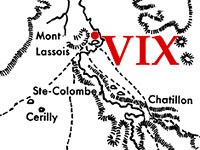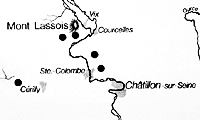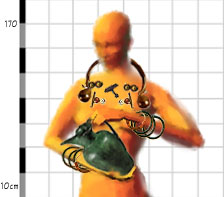Vix (Mont Lassois), France.
|
Localized on map. Vix lies to
the west of the central Hallstatt area, but in the middle of
the La Tène area. Note the situation near the Seine,
very convenient for transferring goods to land
transportation between the Seine and the Rhône. Tin
from the British isles may have been transported south
overland from Vix. 
|
Routes of access to Mont
Lassois -- transportation of goods and tin(?) using both
overland and river routes. The two tumuli of Sainte-Colombe,
La Butte and La Garenne, also contained extremely rich
Hallstatt wagon burials.
after Joffroy 1979, 26 fig.
4
|
|
Area of Mont Lassois. The tomb
was discovered in 1952 at Seine-level at the foot of Mont
Lassois.

after Joffroy 1979, 17 fig. 2
|
Plan of tomb with main groups
of finds marked in color. The wood-clad chamber is ca. 3m x
3m. The corpse lay with her head to the north on the bed of
her wagon.

after Joffroy 1979, 96 fig. 79
|
 The occupant of the chamber was a female in her thirties,
according to anthropologists. The character of the assemblage has led
some to question her sex, even to suggest that a transvestite was
buried in the tomb (note). Her
skull is larger than typical for females, with a capacity of 1,425
cm3, and hyperdolichocephalic (long-headed). I have made
her stand-in taller than the average Hallstatt woman, ca. 172 cm in
height, because of the large cranium -- the long bones were not
adequately preserved to determine height.
The occupant of the chamber was a female in her thirties,
according to anthropologists. The character of the assemblage has led
some to question her sex, even to suggest that a transvestite was
buried in the tomb (note). Her
skull is larger than typical for females, with a capacity of 1,425
cm3, and hyperdolichocephalic (long-headed). I have made
her stand-in taller than the average Hallstatt woman, ca. 172 cm in
height, because of the large cranium -- the long bones were not
adequately preserved to determine height.
My distribution of the fibulae is
entirely fictitious. They were found along both sides of the body.
The plans do not indicate which fibula was found where, however, so I
have tried to give an idea of size and type alone.
The composite below gives an impression of the enormous size of
the krater. The "lady" could very well
have been as short as the krater's 1.64 m. The
wagon was dismantled in the tomb; the
bed is only ca. 1.35 m long, much too short to have carried the
"lady" in an ekphora. In addition
to the gold torc, she wore large amounts
of jewelry of bronze, iron, amber,
coral and gold. She was well provided for
banqueting in the afterlife, with the
huge krater, Etruscan Schnabelkanne, three large bronze
basins, a silver phiale, and two imported Attic kylikes.

Châtillon-sur-Seine: Musée
Archéologique.
Comparandum: Mitterkirchen female
burial.
 Home
Home




 The occupant of the chamber was a female in her thirties,
according to anthropologists. The character of the assemblage has led
some to question her sex, even to suggest that a transvestite was
buried in the tomb (note). Her
skull is larger than typical for females, with a capacity of 1,425
cm3, and hyperdolichocephalic (long-headed). I have made
her stand-in taller than the average Hallstatt woman, ca. 172 cm in
height, because of the large cranium -- the long bones were not
adequately preserved to determine height.
The occupant of the chamber was a female in her thirties,
according to anthropologists. The character of the assemblage has led
some to question her sex, even to suggest that a transvestite was
buried in the tomb (note). Her
skull is larger than typical for females, with a capacity of 1,425
cm3, and hyperdolichocephalic (long-headed). I have made
her stand-in taller than the average Hallstatt woman, ca. 172 cm in
height, because of the large cranium -- the long bones were not
adequately preserved to determine height.
